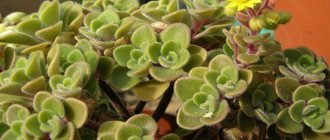Author: Elena N. https://floristics.info/ru/index.php?option=com_contact&view=contact&id=19 Category: Houseplants Published: September 13, 2018Last edits: January 11, 2021
- Diseases and their treatment
- Red Pachystachys (Pachystachys coccinea)
Pachystachys (lat. Pachystachys) is a genus of evergreen flowering plants of the Acanthaceae family, which includes about 12 species growing in subtropical and tropical regions of America and Eastern India. In indoor floriculture, the species Pachistachis yellow has been known since the 19th century, but it is still not a very frequent visitor to our windowsills. Translated, the word “pachystachys” means “thick spike” or “thick spike”: the inflorescence of these plants is a dense spike. We call pachistachis “golden candle” or “golden shrimp”.
Planting and caring for pastachis
- Flowering: from February to October.
- Lighting: bright diffused light.
- Temperature: during the active growing season - the usual temperature for a living room, during the dormant period - within 18-16 ºC. The lower temperature threshold is 10 ºC.
- Watering: during the period of active growth - regular and plentiful, during the dormant period - moderate to meager.
- Humidity: high. It is recommended to keep the plant on a tray with wet pebbles.
- Feeding: from spring to autumn - 2 times a month with complex mineral fertilizer for flowering plants in liquid form. In winter, it is enough to fertilize once every month and a half.
- Dormant period: from mid-autumn to late winter.
- Transplantation: at the end of winter: young plants - annually, adults - once every 3 years.
- Pruning: regular, at the end of the growing season.
- Reproduction: cuttings, less often – seeds.
- Diseases: root rot, as well as failure to bloom and loss of attractiveness as a result of improper care or violation of maintenance conditions.
- Pests: spider mites, mealybugs, scale insects, thrips and whiteflies.
Read more about growing pachistachis below.
Watering frequency
How to water a flower? Tropical crops require high humidity. It is recommended to pay special attention to the root system. The soil substrate should not dry out. That is why the pots with the plant are regularly watered with water at room temperature.
If the flower is located in a cool room, then watering is reduced to 5 times a week. Special fertilizer formulations will help compensate for the lack of nutrients. Professional gardeners recommend adding a little wood ash. An infusion of onion peels will help prevent viral and fungal infections.
During the flowering period, Pachistachis is regularly fed with complex formulations. Before this, 5-7 g of the nutrient mixture are pre-dissolved in the liquid. To maintain the decorative qualities of a flowering shrub, it is enough to carry out 1-2 feedings during the flowering period.
Caring for pastachis at home
Growing conditions
The indoor flower pachistachis is a warm and light-loving plant; it needs bright, diffused light for normal growth and development, so the best place for a flower in an apartment is north-eastern windows. On southern window sills, pachistachis should be shaded from direct rays, at least during midday, when the sun is especially hot.
Under natural growing conditions, the lower temperature threshold for pachystachys is 10˚C, but a long stay at this temperature leads to loss of leaves, so at home the dormant period should take place at a temperature not lower than 16˚C. In summer, the pachistachis plant normally tolerates the temperature natural for our latitudes. Vacations in the fresh air - on the terrace, in the garden or on the balcony - will benefit the plant, but only if you provide it with protection from precipitation, wind and drafts.
- Aspidistra - care, photos, types
Watering and fertilizing
Pachistachis will need regular and abundant watering during the growing season (depending on the air temperature once every 3-7 days), and during the dormant period it will need moderate to scanty watering if the pachistachis spends the winter in conditions of low air temperature. If you do not have the opportunity to place the plant in a cool room for the winter, then water it as usual.
The leaves of pachystachys, which droop and droop from thirst, will tell you that it’s time to water the plant. However, it is better not to wait for such hints, but to water the soil in the pot as soon as its top layer dries.
To moisten the substrate, melt water is used, passed through a filter or left to stand for 24 hours. The water temperature for irrigation should be 1-2 degrees warmer than in the room.
Tips for growing aphelandra on a windowsill
Caring for pastachis at home involves the application of fertilizers. Pachistachis is fed during the period of active growth 2 times a month with complex mineral fertilizer, which is applied in the form of a solution to a pre-moistened substrate. You can fertilize pachistachis with organic matter, for example, a solution of mullein or chicken manure, which is sold in specialized stores in ready-to-use form. If pachistachis does not rest in winter, feed it with a mineral complex once every 1-1.5 months.
In the photo: Growing pachistachis at home
Transfer
Young pachistachis are replanted annually in the spring, before flowering begins. For adult plants, the pot should be changed no more than once every three years. For pachistachis, you need an earthen mixture of equal parts of peat, leaf soil, humus, turf soil and coarse river sand. The soil should be disinfected two weeks before replanting by heating it in the oven or spilling it with a strong solution of potassium permanganate. You must first lay a layer of drainage material at the bottom of the new pot, and the flower should be trimmed before replanting. Pachistachis prepared for transplantation is transferred from the old pot to a new one, after which the voids are filled with soil mixture, the substrate is compacted and watered. The plant should be protected from the sun for several days after transplantation.
How to grow crossandra on a windowsill
Trimming
The flower is trimmed regularly, otherwise it will become unattractive due to the shoots exposed at the bottom. When and how to prune pachistachis? At the end of the dormant period, the shoots of the plant are cut off, leaving only 10-15 cm. The cuttings can be used as cuttings for propagation.
- Indoor rhododendron (names and photos)
Pachistachis flowering
Pachistachis blooms from February to October. You can, of course, make it bloom in winter, but this will require additional lighting. The funny spikes of Pachistachys resemble the inflorescences of Aphelandra, which is not surprising, only in Pachistachys they are more elongated. The inflorescences are attracted by yellow bracts that do not fade for several weeks. And the flowers themselves - spongy, light, almost white - fall off very quickly, after 3-4 days.
Problems with flowering can only occur if the plant does not have enough light. Old, elongated and bald pachistachys in the lower part of the shoots form a small number of inflorescences, and flowers form only on young shoots, so if you want to get more inflorescences, force the plant to branch.
Pachistachis begins flowering at an early age: in some cases, cuttings bloomed within a couple of months after rooting.
New ones branch off from wilted pachystachys inflorescences, so flowering can last quite a long time. Still, it is advisable to remove faded spikelets for preventive and hygienic purposes.
Pachistachis yellow - a bright, beautifully flowering soloist with beautiful leaves
Pachistachis belongs to the Acanthaceae family and is a durable, stable ornamental plant, attractive even when inflorescences do not bloom at the ends of the shoots. From the genus Pachystachys, only 2 species are used as cultivated plants, but only yellow pachystachys (Pachystachys lutea) can boast of the greatest popularity. This evergreen perennial is found in nature only in tropical forests, but on three continents - from Australia to East Asia and South America. The name pachistachys translates as “thick ear.”
Despite the fact that the size of pachistachis (on sale) is most often limited to 25-40 cm in height, this plant should not be underestimated for its size. The more mature pachystachys becomes, the more bulky and branched bush it turns into, showing off not only its details, but also its impressive crown. Without control, this plant can grow up to 1.5 m; to maintain a more or less compact shape, it needs constant shaping.
The densely branched shrub produces erect, not too branched shoots, gradually becoming woody from below and appearing thin. The branches of pachystachys are almost completely hidden under large leaves. Broadly lanceolate or lanceolate-ovate, elongated, with a pointed tip, leaves with deep, visible veins and a glossy surface create a strikingly impressive crown with a bright, coolish color, which contrasts perfectly with the color of the apical inflorescences.
The flowering of Pachistachis cannot be called anything other than dazzling. The apical spikelets of inflorescences are formed by tightly seated yellow bracts with a bright, sunny yellow tint of color. Tetrahedral, they appear to be radiant pyramids with a strict geometric structure, capable of reaching 10 cm in length. The real flowers of Pachistachis are white, tubular, with a thin corolla divided into narrow lobes. They peek out between the bracts, as if sticking out to the sides, adding exoticism to the whole plant.
The flowering period of this indoor plant traditionally lasts from March to October, while the flowers fade quite quickly, in 10-12 days. But the bracts of pachystachys in dense spikelets last up to several months, providing the plant with constant decorativeness. Up to 20 inflorescences bloom simultaneously on one plant.
The combination of tones of bright yellow and dark emerald green with light splashes of white turns Pachistachis into one of the most fashionable indoor plants. This culture is considered one of the best soloists, although pachistachis can also be exhibited in a group with other indoor exotics. When choosing a location for pachistachis, you should take into account the possibility of increasing air humidity. This plant is often called one of the most suitable for kitchen interiors, due to its increased moisture requirements and the need to provide a consistently warm environment.
Yellow pachystachys (Pachystachys lutea). © Si Gross
Reproduction of Pachistachis
Most often, the vegetative method of propagation of pachistachis is used - cuttings. As we have already written, shoots cut during spring pruning can be used as cuttings. How to propagate Pachistachis?
You will need apical cuttings with two internodes and two pairs of leaves. For rooting, which takes place most successfully at a temperature of 22˚C, the cuttings are placed cut side down in a container of water. During the process of root growth, leaves may fall off the cuttings, and to prevent this from happening, the leaf blades should be shortened by half. But even if in this case the leaves fall off, do not despair: after planting in the ground, new leaves will appear at the top of the cuttings.
In the photo: Pachistachis flowering
Cuttings are also rooted in a loose substrate of equal parts of leaf soil, humus, peat, turf soil and perlite. A plastic bottle cut off at the top is filled with the soil mixture, and the cut of the planted cuttings is treated with Kornevin before planting in the bottle with the substrate. To create a greenhouse effect, the top of the bottle with the cutting is covered with a film, which is removed from time to time so that the cutting can breathe. Or you can put the upper part of the bottle in which the cutting is planted on the lower part of the bottle and secure it with tape, and for ventilation simply unscrew and remove the cap. Keep the cuttings under bright diffused light.
- Caring for Citrus Plants
There are usually no problems with the rooting of Pachistachis: the roots grow even in cuttings that have lost leaves. When the cuttings acquire a root system, plant 3-4 of them in a low and wide pot: in the form of a bush, pachistachis looks much more attractive. And don't forget to pinch the tops of the stems from time to time.
Pests and diseases
Diseases and their treatment
When growing pachystachys in heavy soil, abundant and frequent watering can lead to stagnation of water in the roots and damage the plant to root rot. Inspect the root system of Pachistachis, and if it is not completely rotten, remove the affected areas, keep the roots in a fungicide solution and plant the plant in a fresh, more suitable substrate. However, it is not always possible to save a plant from this fungal disease, even if you reduce watering and at first use a fungicidal solution to moisten the substrate.
To prevent root rot from developing, monitor the condition of the substrate in the pot: it should be loose and light. And be sure to drain the water that leaks into the pan after watering.
If you are keeping a pot of pastachis on a tray of wet pebbles, position it so that the pot's drainage holes are not submerged in water. Water should saturate the substrate with moisture, and not stagnate in it.
In the photo: How to grow pachistachis
All other troubles arise in pachistachis from improper care or as a result of non-compliance with the conditions for its cultivation.
- For example, if a flower's leaves have fallen off, this is evidence that you did not water it enough or kept it in a draft.
- Curled leaves and dry tips are a sign of too low air humidity in the room.
- Strongly elongated stems, lack of flowering and small leaves indicate that pachistachis suffers from a lack of light.
- Slow development and stunted growth mean that it is time to change the substrate in the pot, and shoots exposed at the bottom hint that the pachistachis requires rejuvenation - short pruning.
Pests and their control
Most often, indoor pachistachis is affected by mealybugs, scale insects and spider mites. All of them feed on the cell sap of the plant. If you notice white cotton-like lumps in the leaf axils or small yellow dots on the leaf blades, take action immediately. Scale insects and scale insects should be removed from the plant with a cotton swab dipped in alcohol. Mites are not so easy to detect due to their small size, but a sign of their presence, in addition to pinpoint bites on the leaves, is a thin web. Wash the pachistachis in the shower, protecting the substrate from soapy water, then let the plant dry and treat the leaves with Actellik or Fitoverm. It is better to spray pachistachis outdoors.
Occasionally, Pachistachis is occupied by whiteflies and thrips, which also feed on cell sap. Measures to combat these pests are the same as for ticks, scale insects and scale insects.
Possible problems during care
Pachystachys diseases
This plant gets sick very rarely. But some problems may arise. Many people do not know why pachistachis leaves curl .
In fact, this occurs when care rules are not followed . To restore their former beauty, you will need to increase watering and move the flowerpot to a drier place.
Important! Pachistachis can shed its leaves. If this happens in late autumn, then everything is fine. In this way, the flower prepares for winter. In this case, you will need to trim all the shoots, leaving 10 to 12 cm.
At high air temperatures, the tips of leaf blades often dry out . This is very dangerous, as the heat can lead to the death of the bush.
Types and varieties
a description of the most commonly grown home-grown yellow pachystachys (Pachystachys lutea) at the beginning of the article, but sometimes two more species can be found in indoor and greenhouse culture:
Red Pachystachys (Pachystachys coccinea)
Mainly a greenhouse plant, since this species reaches a height of 2 m. Its bright green, sometimes covered with burgundy streaks, leaves up to 40 cm long are located on short petioles. The bracts are also green, and the elongated tubular red flowers look like the feathers that were once used to decorate hats. Because of the flowers, this species is called "Cardinal's Guard".
In the photo: Red Pachystachys (Pachystachys coccinea)
Pachystachys spicata
A species that is grown mainly in botanical gardens and is a rare representative of the genus in home collections. It has dark green leaves up to 25 cm in length and bright red flowers collected on a cone-shaped bract. Some experts consider Pachistachis spicata not an independent species, but a variety of Pachistachys red, but there is still no clarity on this issue.
In the photo: Pachystachys spicata
How to prune a plant to form a bush
In order for the plant to maintain its beauty, it needs regular pruning and pruning. Nature has it in such a way that in the first years of a plant’s life, growth occurs in one trunk, without branching. After growth stops, active formation of lateral branches begins. At home, this process can be controlled. Before pruning a plant to form a bush, it is important to think about the future shape of the crown. Experts advise shaping the plant from the first year of life; the first pruning should occur at a height of 10-15 cm. The third pair of leaves should be removed from the buds of the side shoots and repeated throughout all tiers of shoots. It is necessary to repeat pinching 3-4 times in the first year of life - this will allow you to get a well-groomed, fluffy and low bush.
Pruning of all tops should occur in early spring, before the active growth stage begins. The procedure must be repeated every year.
Pakhistakhis - signs and superstitions
Pachistachis is credited with magical properties: it fills the house with vitality, has a beneficial effect on the human nervous system, that is, it has a calming effect on hyperactive people and at the same time activates passive household members. The yellow color of the bracts of pachystachys leaves has a positive effect on the relationship between spouses, helping to smooth out conflicts and develop compromise solutions.
Some signs are also associated with pastachis. For example, if, with normal care, the plant’s inflorescences suddenly begin to fall off and the leaves dry out, this portends troubles with or among relatives. But the unexpectedly bright color of the bract leaves is a sign of an approaching pleasant event. Pachistachis presented as a gift is a wish for happiness in your personal life, which, they say, always comes true.
general information
Wild Pachistachis grows in the south, but since its discovery many decorative domestic varieties have already been developed. This is an evergreen shrub up to 1-2 m in height with unusual inflorescences. First, it produces yellow or red scaly spikelets, from which tubular flowers then emerge.
When formed and properly cared for, pachistachis grows into a large spherical bush. But you can grow it more like a tree. The beautiful leaves of a rich green hue are spectacular in themselves. Flowering lasts all summer.
Photo: na-dache.pro











